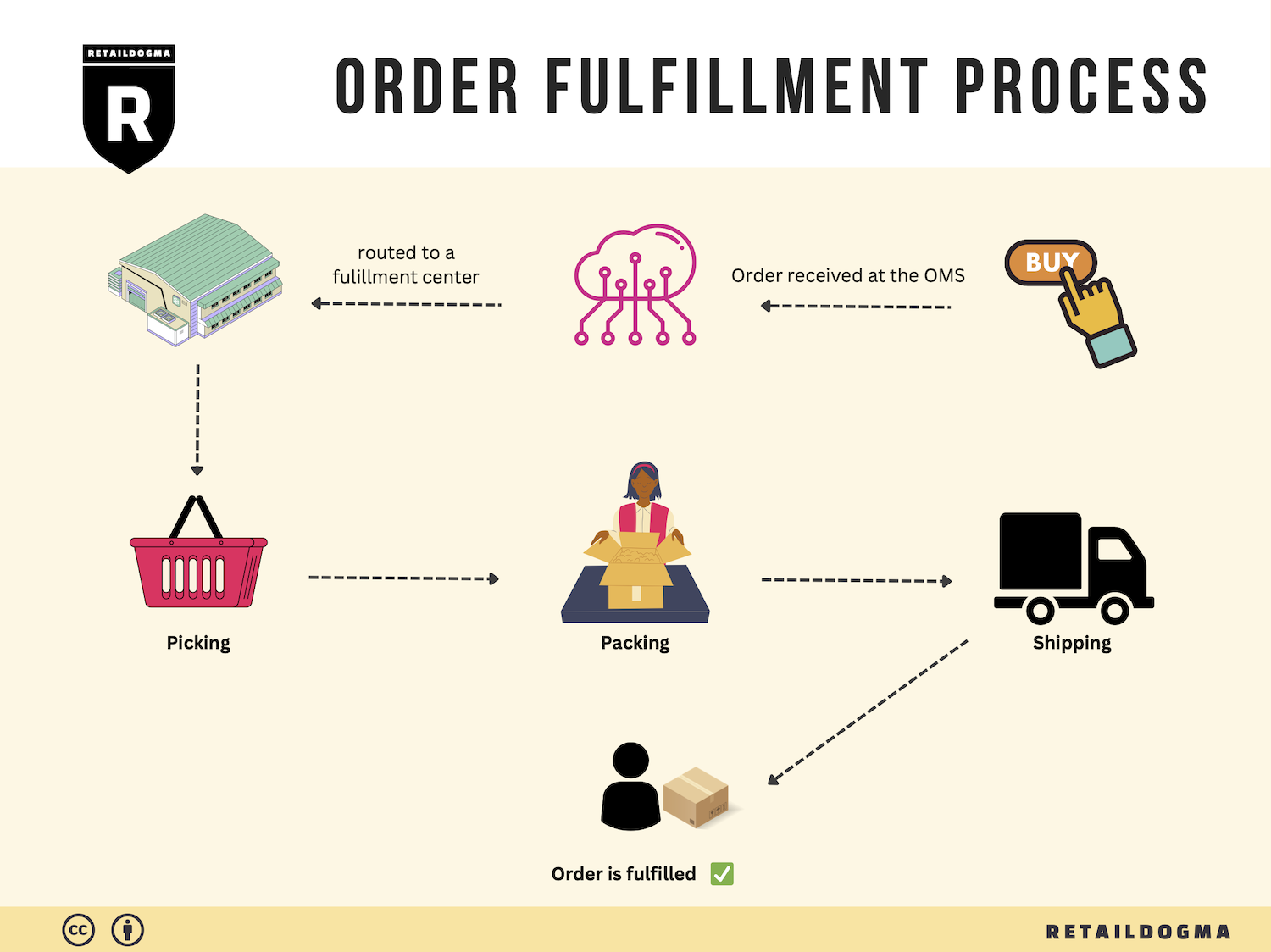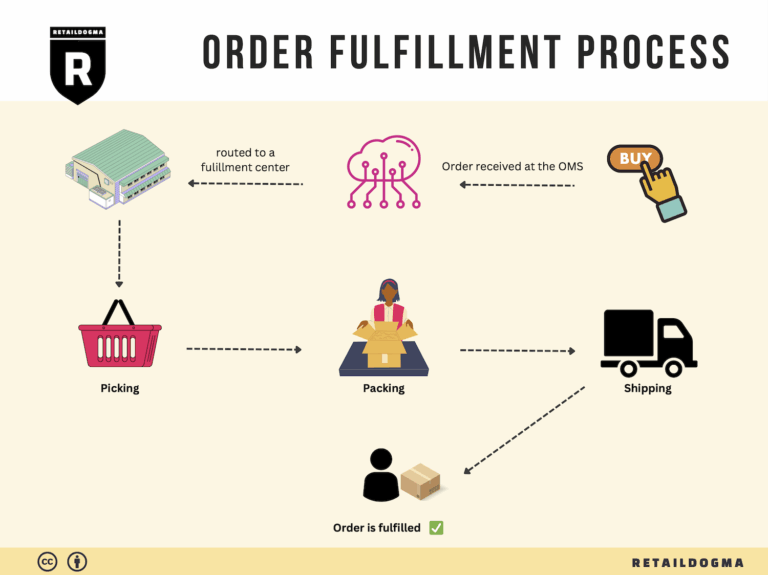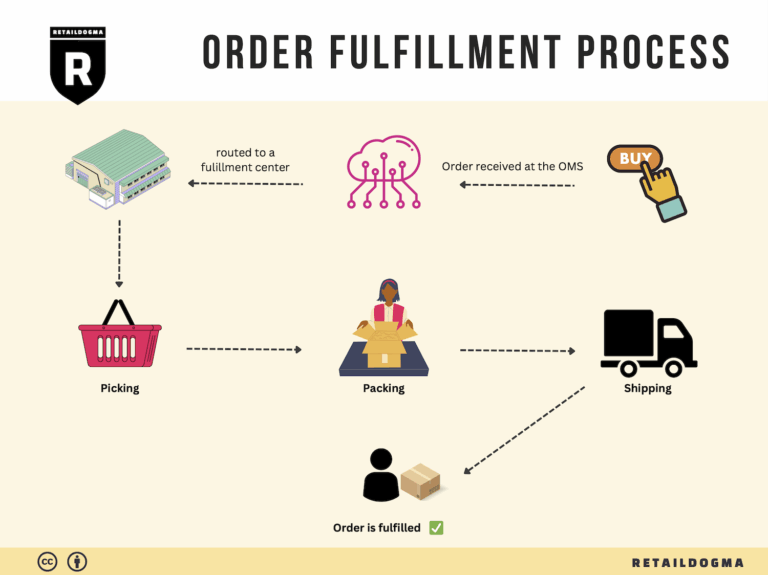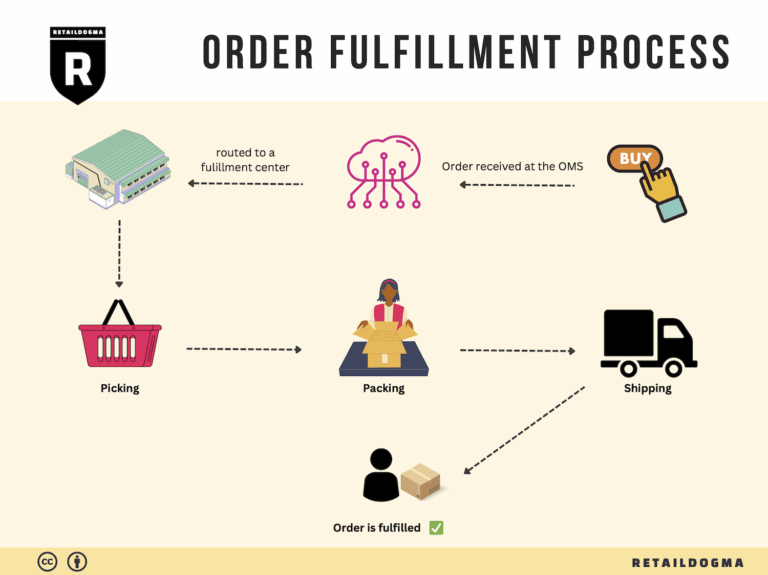Ecommerce Fulfillment Services: The Ultimate Guide (2025)
What is E-commerce Fulfillment? An Introduction for Growing Businesses
As e-commerce businesses grow, many owners find themselves overwhelmed by the logistics of packing and shipping orders. The excitement of scaling can quickly turn into stress as inventory piles up and the demand for timely deliveries increases. This is where the importance of a solid fulfillment strategy becomes crucial.
Understanding Fulfillment
At its core, e-commerce fulfillment is the process of getting a product from your warehouse or storage to your customer’s doorstep. This involves a series of steps: managing inventory, picking and packing orders, shipping products, and handling returns. For many growing businesses, attempting to manage these processes in-house can lead to inefficiencies, errors, and ultimately, dissatisfied customers.
What This Guide Covers
In this comprehensive guide, we will explore various fulfillment models that can streamline your operations, including third-party logistics (3PL) and Fulfillment by Amazon (FBA). Understanding these models will help you determine which approach aligns best with your business goals and customer expectations.
We will also delve into the core services provided by fulfillment partners, such as inventory management, order processing, and shipping solutions. Knowing what services are available allows you to tailor your fulfillment strategy to your specific needs, ensuring that you can focus on growing your brand while leaving logistics to the experts.
Choosing the right fulfillment partner is a critical decision that can impact your business’s efficiency and customer satisfaction. This guide will provide insights on how to evaluate potential partners based on factors such as pricing, service capabilities, and performance metrics.
Finally, we will discuss pricing structures associated with different fulfillment options, helping you to understand the cost implications of outsourcing your logistics. This knowledge will empower you to make informed decisions that balance quality service with your budget.
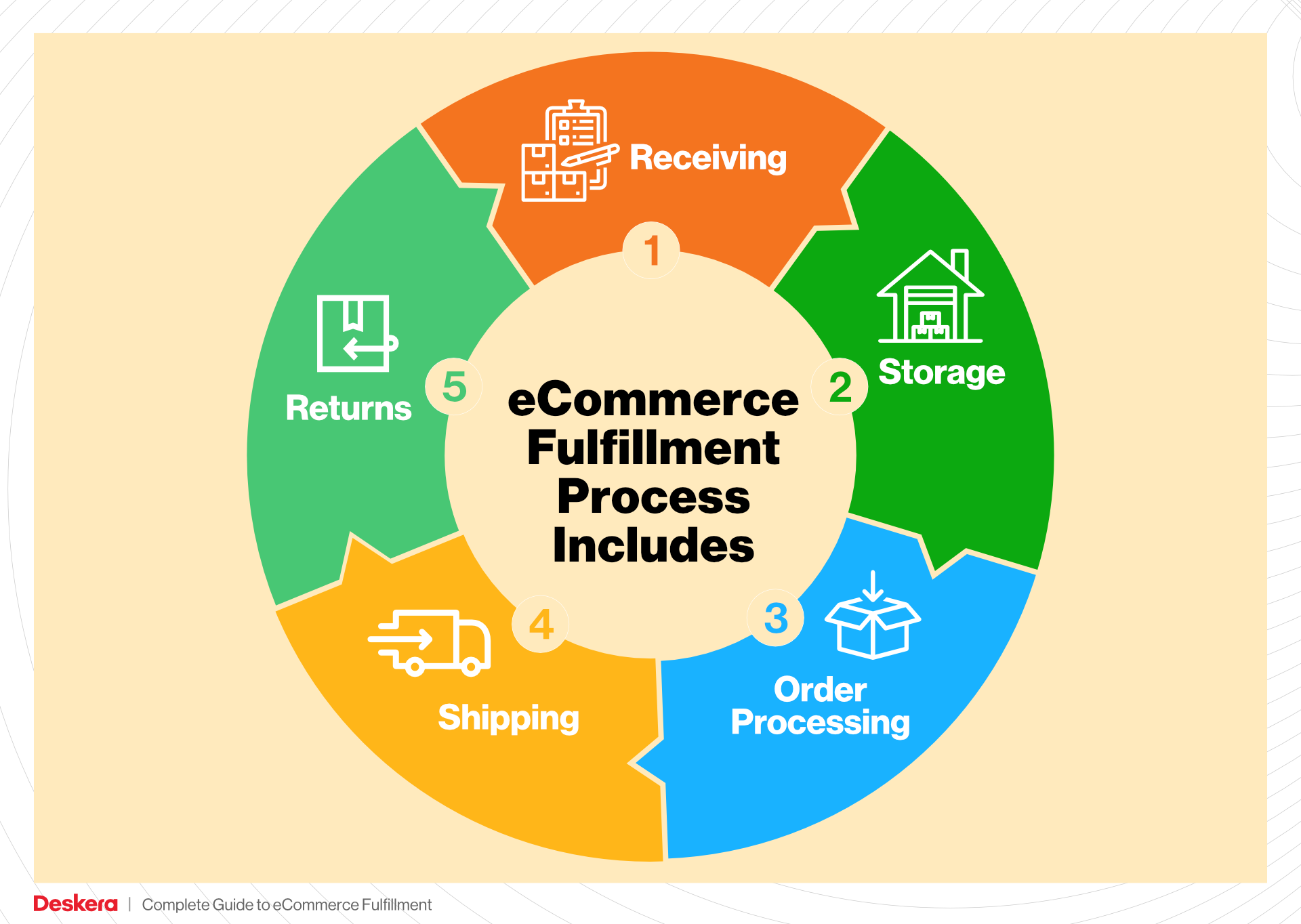
Empowering Smart Logistics Decisions
The goal of this guide is to empower you, as a business owner or operations manager, to make smart and strategic decisions about your logistics. By understanding the nuances of e-commerce fulfillment and leveraging the right resources, you can enhance your operational efficiency, improve customer satisfaction, and ultimately scale your business with confidence. Let’s dive in and explore how you can optimize your fulfillment strategy for success.
What You’ll Learn In This Guide
- What is E-commerce Fulfillment? An Introduction for Growing Businesses
- The Order Fulfillment Process: From ‘Buy’ Button to Customer’s Door
- Comparing Fulfillment Models: In-House vs. 3PL vs. Dropshipping
- A Deep Dive into Amazon FBA: Pros, Cons, and Who It’s For
- Core Services Offered by Fulfillment Centers
- How to Choose a Fulfillment Partner: A 6-Point Checklist
- Understanding Fulfillment Pricing: A Breakdown of Common Fees
- Frequently Asked Questions (FAQs) about Fulfillment
- Conclusion: Is Outsourcing Fulfillment the Right Move for Your Business?
- Important Disclaimer
The Order Fulfillment Process: From ‘Buy’ Button to Customer’s Door
1. Receiving Inventory
The first step in the order fulfillment process is receiving inventory from suppliers or manufacturers. This involves inspecting shipments for accuracy and quality, verifying that the correct products and quantities have been delivered, and documenting any discrepancies or damages. A key term associated with this step is SKU (Stock Keeping Unit), a unique identifier for each product that helps streamline inventory management.
This step is crucial because accurate receiving ensures that your inventory records match the physical stock on hand. Discrepancies at this stage can lead to stockouts or overstock situations, both of which can hinder your ability to fulfill customer orders promptly. By maintaining a well-organized receiving process, businesses can minimize errors and establish a reliable foundation for the subsequent steps in fulfillment.
2. Warehouse Storage
Once inventory is received, it needs to be stored in a warehouse. Effective warehouse storage involves strategically placing products in designated locations to optimize space and improve accessibility. Key terms here include bin locations and inventory management systems (IMS), which help track where items are stored and monitor stock levels.
Proper warehouse storage is vital for maintaining order accuracy and speeding up the fulfillment process. A well-organized warehouse allows staff to easily locate products when orders come in, reducing the time spent searching for items. Additionally, employing an IMS can provide real-time visibility into inventory levels, enabling businesses to make informed decisions about reordering and stock management.
3. Order Picking
Order picking is the process of selecting items from the warehouse to fulfill customer orders. This step often utilizes pick lists, which are documents that detail the items and quantities needed for each order. Efficient picking methods, such as batch picking or zone picking, can significantly enhance productivity.
This stage is essential because it directly impacts the speed and accuracy of order fulfillment. Errors in picking can lead to incorrect shipments, resulting in dissatisfied customers and increased return rates. By implementing systematic picking processes and utilizing technology like barcode scanners, businesses can minimize errors and ensure that the right products are selected for each order.
4. Order Packing
After items have been picked, they must be packed for shipping. This step involves securely packaging products to prevent damage during transit, as well as including necessary documentation such as packing slips and return instructions. Key considerations include packaging materials and dimensional weight, which can affect shipping costs.
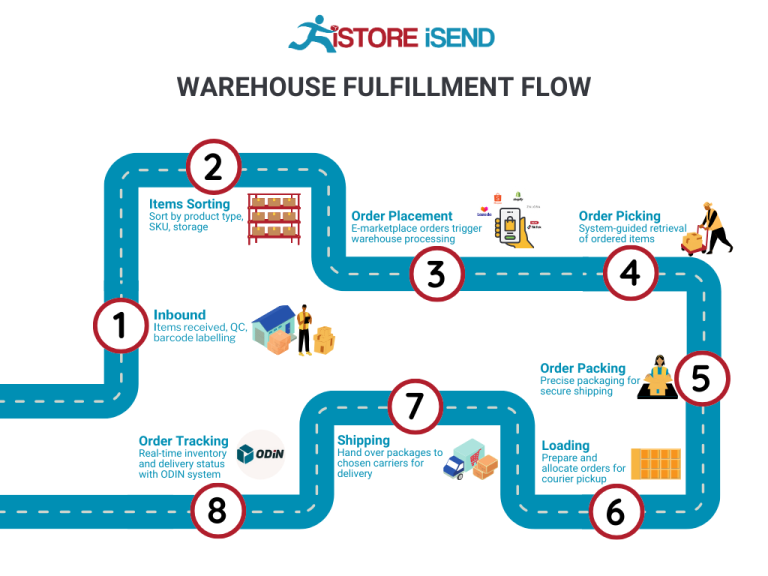
Order packing is critical for protecting items and ensuring a positive customer experience. Well-packed orders not only reduce the likelihood of damage but also enhance the perception of your brand. Additionally, using appropriate packaging can help optimize shipping costs, as carriers often charge based on the size and weight of packages. By investing in quality packing materials and processes, businesses can improve their overall fulfillment efficiency.
5. Shipping & Delivery
The final step in the fulfillment process is shipping and delivery. This involves selecting a shipping carrier, generating shipping labels, and dispatching packages to customers. A key term associated with this step is last-mile delivery, which refers to the final leg of the shipping journey from a distribution center to the customer’s doorstep.
Shipping and delivery are crucial for customer satisfaction, as timely delivery is often a key determinant of a positive shopping experience. Delays or issues at this stage can lead to customer dissatisfaction and loss of repeat business. By leveraging a reliable shipping network and offering various delivery options, such as expedited shipping, businesses can enhance their service offerings and meet customer expectations. Furthermore, tracking systems allow customers to monitor their orders, providing transparency and building trust in your brand.
In conclusion, understanding and optimizing each step of the order fulfillment process is essential for e-commerce businesses looking to scale efficiently. From receiving inventory to delivering products to customers, each phase plays a vital role in ensuring that orders are fulfilled accurately and promptly. By focusing on these key areas, businesses can enhance their logistics operations, improve customer satisfaction, and ultimately drive growth.
Comparing Fulfillment Models: In-House vs. 3PL vs. Dropshipping
Fulfillment Model Comparison
| Model | Who Handles Inventory | Best For (Business Stage) | Key Advantage | Key Disadvantage |
|---|---|---|---|---|
| In-House Fulfillment | The business itself | Startups and small businesses | Complete control over inventory and fulfillment | Requires significant time and resource investment |
| Third-Party Logistics (3PL) | A third-party logistics provider | Growing and scaling businesses | Reduced overhead and faster shipping | Less control over fulfillment process |
| Dropshipping | Supplier or manufacturer | New entrepreneurs and niche markets | Low upfront costs and no inventory management | Longer shipping times and lower profit margins |
In-House Fulfillment
In-house fulfillment involves managing the entire logistics process within your own business. This means that you are responsible for storing inventory, picking and packing orders, and shipping them directly to customers. For startups and small businesses, this model can provide a higher level of control over the fulfillment process, allowing for tailored customer experiences and direct oversight of inventory. However, while the benefits include a deep understanding of your product handling and customer service, the key disadvantage is the significant time and resource investment required. As your order volume grows, managing fulfillment in-house can become cumbersome and hinder your ability to focus on scaling the business. Additionally, the need for warehouse space, packing materials, and shipping logistics can lead to increased overhead costs.
Third-Party Logistics (3PL)
Third-party logistics, or 3PL, involves outsourcing your fulfillment operations to a specialized logistics provider. This model is ideal for businesses that are growing and need to scale quickly without the burden of managing logistics in-house. 3PL providers handle everything from inventory storage to order fulfillment, allowing you to focus on core business activities like marketing and product development. One of the main advantages of using a 3PL is the potential for reduced operational costs, as these providers often leverage volume-based shipping discounts and have established relationships with carriers. However, the downside is that you relinquish a degree of control over the fulfillment process. Issues such as order accuracy, shipping times, and customer service may be less directly managed, which can impact customer satisfaction if not handled properly. It’s crucial to choose a reputable 3PL partner to mitigate these risks.
Dropshipping
Dropshipping is a fulfillment model where the retailer does not hold inventory but instead forwards customer orders directly to a supplier or manufacturer, who then ships the products directly to the customer. This model is particularly appealing for new entrepreneurs and those operating in niche markets, as it requires minimal upfront investment and eliminates the need for inventory management. The key advantage of dropshipping is the low financial risk; you only pay for products once you make a sale, which allows for greater flexibility in testing new products and markets. However, dropshipping comes with its own set of challenges. Shipping times can be longer, as products may need to travel from the supplier to the customer, which can lead to dissatisfaction if not clearly communicated. Additionally, profit margins can be lower compared to other fulfillment methods due to the supplier’s cut and potential shipping costs. Moreover, since you do not control inventory, managing stock levels and product quality can be tricky, potentially affecting your brand reputation.
Conclusion
Choosing the right fulfillment model for your e-commerce business is a critical decision that can significantly impact your operational efficiency, customer satisfaction, and overall growth potential. In-house fulfillment offers control and direct oversight, making it suitable for smaller businesses, while 3PL provides scalability and cost efficiency for growing companies. Dropshipping, while low-risk and easy to implement, requires careful management of supplier relationships and shipping expectations. Assessing your business stage, product type, and growth ambitions will help you determine which fulfillment model aligns best with your strategic goals.
A Deep Dive into Amazon FBA: Pros, Cons, and Who It’s For
Understanding Fulfillment by Amazon (FBA)
Fulfillment by Amazon (FBA) is a logistics service offered by Amazon that allows e-commerce sellers to store their products in Amazon’s fulfillment centers. Amazon then takes care of storage, packaging, shipping, and customer service on behalf of the sellers. This service is designed to simplify the order fulfillment process, allowing businesses to leverage Amazon’s extensive logistics network and customer base.
When a customer places an order for a product fulfilled by Amazon, the order is processed through Amazon’s systems. The product is picked from the fulfillment center, packed, and shipped directly to the customer. Additionally, Amazon handles returns and customer inquiries, providing a seamless experience for both sellers and buyers.
How FBA Works
-
Product Listing: Sellers create listings for their products on Amazon’s marketplace. They can choose to enroll their products in FBA.
-
Inventory Shipment: Sellers send their products to Amazon’s designated fulfillment centers. Amazon provides guidance on how to prepare and package products for shipment.
-
Storage: Products are stored in Amazon’s warehouses until a customer places an order.
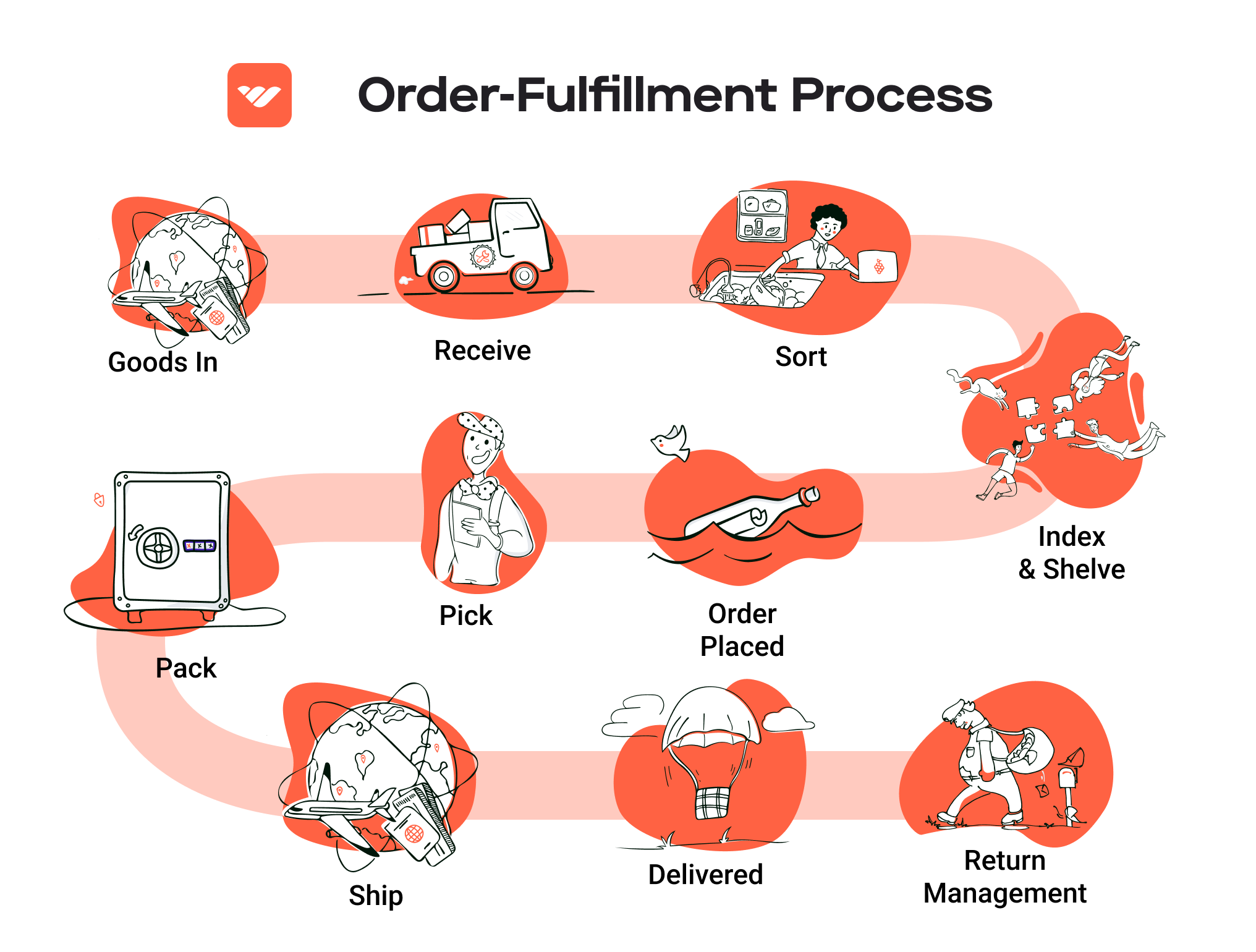
-
Order Processing: When an order is placed, Amazon picks, packs, and ships the product. They also handle shipping notifications and tracking.
-
Customer Service: Amazon manages customer service inquiries and returns, providing support to buyers.
-
Payment: After an order is fulfilled, Amazon deposits the proceeds into the seller’s account, minus any applicable fees.
Pros of Using FBA
1. Prime Eligibility
One of the most significant advantages of FBA is that it makes products eligible for Amazon Prime. This can greatly enhance visibility and attractiveness to customers who prefer fast, free shipping options. Prime members often seek out FBA products, which can lead to increased sales and higher conversion rates.
2. Customer Trust
Products fulfilled by Amazon benefit from the trust associated with the Amazon brand. Customers feel more secure purchasing items that are backed by Amazon’s fulfillment and customer service, which can result in higher sales for sellers.
3. Multi-Channel Fulfillment
FBA allows sellers to fulfill orders from various sales channels, not just Amazon. This means that if you sell on your own website or other platforms, you can still use Amazon’s fulfillment services to handle those orders, streamlining logistics and inventory management.
4. Scalability
FBA provides a scalable solution for growing businesses. Sellers can increase their inventory without worrying about storage space or logistics, allowing them to focus on marketing and sales strategies.
5. Advanced Logistics
With FBA, sellers gain access to Amazon’s sophisticated logistics and shipping capabilities. This includes advanced technology for tracking shipments, managing inventory, and optimizing shipping routes.
Cons of Using FBA
1. High Fees
FBA comes with various fees, including storage fees for holding inventory and fulfillment fees for picking, packing, and shipping products. These costs can accumulate, especially for sellers with lower margins or slow-moving inventory.
2. Strict Inventory Rules
Amazon has stringent guidelines regarding inventory management. Sellers must adhere to specific packaging and labeling requirements. Failure to comply can result in additional fees or inventory being returned to the seller.
3. Commingling Risks
With FBA, Amazon may commingle inventory from different sellers. This means that if one seller’s product has quality issues, it can impact the reputation of other sellers who share the same inventory pool. This risk can be particularly concerning for brands that prioritize quality control.
4. Loss of Control
By using FBA, sellers relinquish some control over the fulfillment process. This includes aspects such as packaging and shipping times, which can be a concern for brands that want a specific customer experience.
5. Complexity in Returns
While Amazon handles returns for sellers, the process can be complex. Sellers may find it challenging to manage returns and restocking, especially if they have specific policies or need to track returned items closely.
Who is FBA Best For?
Fulfillment by Amazon is best suited for:
-
Small to Medium-Sized E-commerce Businesses: Sellers looking to expand their reach quickly without investing heavily in logistics and warehousing can benefit from FBA’s extensive network.
-
Brands Seeking to Boost Visibility: Businesses that want to leverage Amazon’s Prime program and the trust associated with Amazon’s brand will find FBA advantageous.
-
Multi-Channel Sellers: Brands that sell on multiple platforms and want a streamlined fulfillment process can use FBA for all their order fulfillment needs.
-
Sellers with High Sales Volumes: Businesses that have a steady flow of orders and can absorb the associated fees will find FBA to be a cost-effective solution.
-
New Entrepreneurs: For those just starting in e-commerce, FBA provides an accessible way to enter the market without the overhead of managing logistics.
In conclusion, while Fulfillment by Amazon offers significant advantages in terms of customer trust, scalability, and logistics capabilities, it also comes with its own set of challenges, including fees and loss of control over the fulfillment process. Understanding these pros and cons is crucial for e-commerce business owners when considering whether FBA is the right fit for their operations.
Core Services Offered by Fulfillment Centers
Inventory Management & Warehousing
One of the foundational services offered by fulfillment centers is inventory management and warehousing. This service involves the systematic storage of products in a designated facility, where they can be easily accessed and managed. Fulfillment centers utilize advanced inventory management systems that track stock levels, manage reorders, and provide real-time data on inventory status.
Benefits for E-commerce Businesses:
-
Optimized Storage Solutions: Fulfillment centers are equipped to handle various product types and sizes, providing tailored storage solutions that maximize space and efficiency. This means businesses can store more products without the need for additional warehouse space.
-
Real-Time Visibility: With sophisticated inventory management software, businesses can gain instant insights into their stock levels. This transparency helps in making informed decisions about purchasing and restocking, reducing the risk of stockouts or overstock situations.
-
Scalability: As e-commerce businesses grow, their inventory needs can change rapidly. Fulfillment centers allow businesses to scale their inventory management up or down based on demand without the burdens of managing physical storage themselves.
-
Cost Efficiency: Outsourcing warehousing to a fulfillment center can significantly lower overhead costs associated with maintaining a warehouse, such as rent, utilities, and staffing. This allows businesses to allocate resources to other areas, like marketing or product development.
Pick and Pack Services
Pick and pack services refer to the process of selecting products from inventory (picking) and then packaging them for shipment (packing). Fulfillment centers streamline this process, ensuring orders are fulfilled accurately and efficiently.
Benefits for E-commerce Businesses:
-
Speed and Accuracy: Fulfillment centers employ trained staff and advanced technology to ensure that orders are picked and packed quickly and accurately. This reduces the likelihood of errors, which can lead to customer dissatisfaction and returns.
-
Efficiency in Order Fulfillment: By using automated systems and optimized workflows, fulfillment centers can handle high volumes of orders with minimal delays. This is particularly beneficial during peak shopping seasons, where demand can spike dramatically.
-
Customized Packaging: Many fulfillment centers offer branded packaging options, allowing businesses to enhance their brand visibility and customer experience. This attention to detail can differentiate a business from its competitors.
-
Integration with E-commerce Platforms: Fulfillment centers often integrate directly with e-commerce platforms, enabling real-time updates and seamless order management. This connectivity helps businesses maintain accurate stock levels and provides customers with tracking information promptly.
Kitting and Assembly
Kitting and assembly services involve the grouping of individual items into ready-to-sell sets or kits. This can include assembling products that require multiple components before they are shipped to customers. Fulfillment centers can handle these processes, which can be labor-intensive and time-consuming for businesses.
Benefits for E-commerce Businesses:
-
Enhanced Product Offerings: By offering kits or bundled products, businesses can create more attractive offerings for customers. This can lead to increased sales as customers are often drawn to bundled deals that provide perceived value.
-
Time Savings: Outsourcing kitting and assembly to a fulfillment center frees up valuable time for e-commerce businesses. Instead of spending time on labor-intensive tasks, businesses can focus on strategic growth initiatives, such as marketing and product development.
-
Quality Control: Fulfillment centers typically implement quality control measures during the kitting and assembly process, ensuring that products meet specific standards before they are shipped. This can reduce the number of returns and enhance customer satisfaction.
-
Flexibility: As businesses introduce new products or change existing offerings, fulfillment centers can quickly adapt their kitting and assembly processes to accommodate these changes. This flexibility is crucial in a fast-paced e-commerce environment.
Returns Management (Reverse Logistics)
Returns management, often referred to as reverse logistics, is the process of handling returned products efficiently. Fulfillment centers manage this process, allowing businesses to streamline returns, inspect items, and reintegrate them into inventory if possible.
Benefits for E-commerce Businesses:
-
Improved Customer Experience: A well-managed returns process can significantly enhance customer satisfaction. Fulfillment centers provide clear return instructions and handle the logistics, making it easier for customers to return products.
-
Cost Reduction: Efficient returns management minimizes the costs associated with processing returns. Fulfillment centers can quickly assess whether returned items can be restocked or need to be disposed of, reducing financial losses.
-
Data Insights: Analyzing return data can provide valuable insights into product performance and customer preferences. Understanding why items are returned can help businesses make informed decisions about inventory, product quality, and customer service.
-
Reputation Management: Companies that handle returns effectively are often viewed more favorably by consumers. A positive returns experience can lead to repeat purchases and customer loyalty, which are crucial for long-term success in e-commerce.
In summary, utilizing the core services offered by fulfillment centers allows e-commerce businesses to streamline their operations, enhance customer satisfaction, and focus on growth. By outsourcing these logistical tasks to experts, businesses can allocate their resources more effectively, paving the way for scalable success in the competitive online marketplace.
How to Choose a Fulfillment Partner: A 6-Point Checklist
Location & Warehouse Network
Importance: The geographical location of your fulfillment partner’s warehouses directly impacts shipping times and costs. A partner with strategically located warehouses can help you reach your customers faster, thereby enhancing their experience and potentially increasing your sales.
Questions to Ask:
– Where are your fulfillment centers located, and how does that align with my target market?
– How do you manage inventory across multiple locations?
– Can you provide insights into your average shipping times to different regions?
Technology & Integrations
Importance: In today’s fast-paced e-commerce environment, having robust technology and seamless integrations with your existing systems (like Shopify) is crucial. This ensures real-time inventory management, order tracking, and efficient communication between your store and the fulfillment partner.
Questions to Ask:
– What technology platforms do you use for order management and inventory tracking?
– How do you integrate with e-commerce platforms like Shopify?
– Can you provide real-time updates on order status, inventory levels, and shipping information?
Specializations (e.g., Cold Storage, Oversized Items)
Importance: Different products have varying storage and handling requirements. If your business deals with specialized items—such as perishable goods, fragile items, or oversized products—partnering with a fulfillment provider that has relevant expertise is essential to avoid damage and ensure compliance with regulations.
Questions to Ask:
– What types of products do you specialize in handling?
– Do you have the capabilities for special storage requirements, such as climate control or oversized item handling?
– Can you provide references from businesses that sell similar products?
Scalability & Capacity
Importance: As your business grows, your fulfillment needs will evolve. A capable partner should not only handle your current volume but also scale operations seamlessly as demand increases. This can prevent potential disruptions in service during peak seasons.
Questions to Ask:
– What is your current capacity, and how do you plan to handle increased order volumes?
– How quickly can you scale operations during peak seasons or unexpected demand surges?
– Do you have a history of managing scalability challenges with other clients?
Pricing and Contracts
Importance: Understanding the pricing structure and contract terms is vital to ensure that your partnership is financially sustainable. Hidden fees can erode your profit margins, so clarity in pricing is essential.
Questions to Ask:
– Can you provide a detailed breakdown of your pricing structure, including storage, picking, packing, and shipping fees?
– Are there any additional fees I should be aware of, such as setup or seasonal costs?
– What are the terms of the contract, and do you offer flexibility for scaling or altering services?
Customer Support & Reviews
Importance: Exceptional customer support can make a significant difference in your partnership. A responsive and knowledgeable support team can resolve issues quickly, minimizing disruptions to your operations. Additionally, checking reviews can give you insights into the partner’s reliability and service quality.
Questions to Ask:
– What level of customer support do you offer (e.g., dedicated account manager, 24/7 support)?
– Can you provide testimonials or case studies from current or past clients?
– How do you handle issues or complaints, and what is your average response time?
Conclusion
Choosing the right fulfillment partner is a critical decision that can impact your e-commerce business’s efficiency, customer satisfaction, and overall growth. By utilizing this checklist and asking the right questions, you can find a partner that aligns with your business needs and supports your scaling efforts effectively.
Understanding Fulfillment Pricing: A Breakdown of Common Fees
Initial Setup Fees
When partnering with a third-party logistics (3PL) provider through the Shopify Fulfillment Network, businesses often encounter initial setup fees. These fees cover the costs associated with onboarding your account, integrating your inventory into their system, and configuring the necessary logistics to handle your products.
Calculation: Initial setup fees can vary significantly between providers, typically ranging from a few hundred to several thousand dollars. Factors influencing these fees include the complexity of your inventory, the level of customization required, and the specific services included in your contract. It’s essential to discuss these upfront costs clearly with your chosen 3PL to avoid unexpected expenses.
Receiving Fees
Receiving fees are charged when your inventory arrives at the fulfillment center. These fees account for the labor and equipment needed to unload, inspect, and store your products safely.
Calculation: Usually, receiving fees are calculated per pallet or per unit received. For instance, a 3PL might charge a flat rate of $20 per pallet or $0.50 per item. Some providers may also have minimum charges to ensure they cover their operational costs, so it’s wise to inquire about these minimums when negotiating your contract.
Storage Fees (per pallet/bin)
Once your inventory is in the fulfillment center, you’ll incur storage fees for the space it occupies. These fees can vary based on the type of storage used, whether it’s pallet storage in a warehouse or bin storage for smaller items.
Calculation: Storage fees are typically charged monthly, either per pallet or per cubic foot. For example, a provider might charge $15 per pallet per month or $0.10 per cubic foot. The total will depend on the amount of inventory you keep on hand and how efficiently you utilize the storage space. As your business scales, it’s crucial to monitor these fees closely, as they can add up quickly with increased inventory.
Pick & Pack Fees (per item/order)
Pick and pack fees are incurred each time an order is fulfilled. This includes the labor involved in picking the items from storage, packing them into shipping boxes, and preparing them for shipment.
Calculation: These fees can be structured in different ways. Some providers charge a flat fee per order (e.g., $2.00 per order), while others may charge based on the number of items being picked (e.g., $0.50 per item). It’s essential to consider your average order size and frequency when evaluating these fees, as they can significantly impact your overall fulfillment costs.
Shipping Fees
Shipping fees are perhaps the most variable and critical component of fulfillment pricing. These fees cover the cost of sending packages from the fulfillment center to your customers, and they can fluctuate based on factors like package weight, dimensions, destination, and chosen shipping speed.
Calculation: Shipping fees are generally calculated based on carrier rates, which can vary widely. Many 3PL providers negotiate bulk shipping rates with carriers and pass those savings onto you. It’s common for shipping fees to be assessed on a per-order basis, but some providers may also offer flat-rate shipping options for specific service levels. Be sure to clarify whether the shipping fees include tracking, insurance, or additional services, as these can further affect your costs.
Tips for Getting an Accurate Quote
-
Detailed Inventory Assessment: Provide your 3PL with a comprehensive list of your products, including dimensions, weights, and seasonal fluctuations in inventory. This information will help them generate a more accurate quote.
-
Understand Your Needs: Clarify your specific fulfillment needs, such as expected order volume, peak seasons, and shipping destinations. This will help the provider tailor their services and pricing to your business model.
-
Compare Multiple Providers: Don’t settle for the first quote. Compare pricing structures and services from several fulfillment partners to find the best fit for your business.
-
Request Itemized Pricing: Ask for a breakdown of all potential fees, including any hidden costs, such as minimum order requirements or additional service charges. This will ensure you understand the full scope of your expenses.
-
Negotiate Terms: Once you have multiple quotes, don’t hesitate to negotiate terms, especially if you anticipate significant order volumes. Many providers are willing to adjust fees based on the potential for long-term partnerships.
By understanding these common fees and how they are calculated, you can make informed decisions about your fulfillment strategy, enabling you to scale your e-commerce business effectively.
Frequently Asked Questions (FAQs) about Fulfillment
1. What is the Shopify Fulfillment Network?
The Shopify Fulfillment Network (SFN) is a service that connects Shopify merchants with third-party logistics (3PL) partners to streamline the order fulfillment process. It allows businesses to outsource inventory storage, order picking, packing, and shipping, enabling them to focus on growth while ensuring faster delivery to customers.
2. How does the Shopify Fulfillment Network work?
Once you install the SFN app and select a 3PL partner, you can send your inventory to their fulfillment centers. When a customer places an order, the 3PL will pick, pack, and ship the product directly to the customer. You can manage and track all aspects of this process directly through your Shopify admin dashboard.
3. What is a 3PL?
A third-party logistics provider (3PL) is a company that offers outsourced logistics services, including transportation, warehousing, and fulfillment. 3PLs help businesses streamline their supply chain operations by managing inventory, shipping, and distribution, allowing merchants to focus on their core business activities.
4. What’s the difference between a warehouse and a fulfillment center?
A warehouse is primarily used for storing goods and may not be optimized for order processing. In contrast, a fulfillment center is designed specifically for picking, packing, and shipping orders quickly. Fulfillment centers often have advanced technology and processes to handle order fulfillment efficiently, reducing shipping times and improving customer satisfaction.
5. How much do fulfillment services cost?
Fulfillment service costs can vary widely based on factors such as order volume, storage space, packaging, and shipping fees. Typically, businesses pay for storage per cubic foot, a fee for each order picked and packed, and shipping costs based on carrier rates. Shopify Fulfillment Network partners may offer volume-based discounts, which can help reduce overall costs.
6. How can using the Shopify Fulfillment Network enhance customer experience?
By leveraging the SFN, businesses can ship from fulfillment centers located closer to customers, which significantly reduces delivery times. Faster shipping leads to higher customer satisfaction and can encourage repeat purchases, ultimately contributing to business growth.
7. How do I monitor my fulfillment process with Shopify?
You can oversee your entire fulfillment process through the Shopify admin dashboard after integrating the SFN app. This includes tracking inventory levels, monitoring order status, and managing returns, all in one centralized location.
8. Can I switch 3PL partners if my needs change?
Yes, Shopify allows you to switch 3PL partners as your business needs evolve. You can compare different fulfillment partners based on pricing, capabilities, and performance metrics and choose the one that best fits your requirements.
9. What types of products are best suited for the Shopify Fulfillment Network?
The SFN is ideal for a wide range of products, particularly those that require fast shipping and efficient order processing. However, businesses should evaluate their specific needs, such as product size, weight, and order volume, to determine if the SFN is the right fit.
10. How do I get started with the Shopify Fulfillment Network?
To get started, simply install the Shopify Fulfillment Network app from the Shopify App Store. From there, you can select a 3PL partner, send your inventory to their fulfillment center, and begin managing your orders directly through your Shopify admin.
Conclusion: Is Outsourcing Fulfillment the Right Move for Your Business?
Evaluating the Benefits of Outsourcing Fulfillment
Outsourcing fulfillment can be a game-changer for e-commerce businesses looking to scale efficiently. By leveraging a fulfillment service, you can save valuable time that would otherwise be spent on inventory management, packing, and shipping. This time savings allows you to focus on strategic growth initiatives, such as marketing and product development, which are crucial for expanding your customer base and increasing sales.
Scalability is another significant advantage of utilizing a fulfillment partner. As your order volume grows, a third-party logistics (3PL) provider can seamlessly adjust to your needs. They have the infrastructure and expertise to manage increased inventory levels and fulfill orders rapidly, ensuring that you can meet customer expectations without the burden of managing logistics in-house. This flexibility is essential for maintaining a competitive edge in today’s fast-paced e-commerce environment.
Moreover, outsourcing fulfillment gives you access to logistics experts who specialize in this area. These professionals can help optimize your supply chain, reduce shipping costs through volume discounts, and enhance the overall customer experience with faster delivery times. Choosing the right fulfillment partner is crucial; their capabilities will directly impact your business’s performance and customer satisfaction.
Take the Next Step
To determine whether outsourcing fulfillment is the right move for your business, consider conducting an audit of your current shipping process. Analyze your order volume, fulfillment speed, and customer feedback. This assessment will provide insights into whether a fulfillment partner could enhance your operations. If you find inefficiencies or challenges, it may be time to explore the Shopify Fulfillment Network and connect with trusted 3PL partners who can support your growth journey. Transitioning to a fulfillment service could be the strategic decision that propels your business to new heights.
Important Disclaimer
⚠️ Important Disclaimer
The information in this guide is for educational purposes. Fulfillment services, pricing, and platform features change frequently. Always conduct your own due diligence and consult with providers directly before making business decisions.
